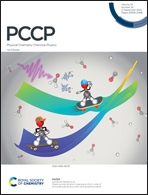Mechanism of the two-dimensional WSeTe/Zr2CO2 direct Z-scheme van der Waals heterojunction as a photocatalyst for water splitting†
Abstract
The direct Z-scheme van der Waals (vdW) heterojunctions based on biomimetic artificial photosynthesis are a promising strategy for enhancing photocatalytic activity. Therefore, the search for superior direct Z-scheme photocatalysts is an urgent task. Herein, we predicted the WSeTe/Zr2CO2 heterostructure as a potential direct Z-scheme photocatalyst based on density functional theory (DFT). The bands of the WSeTe/Zr2CO2 heterojunction follow a typical Type-II arrangement, where the interlayer band gap is smaller than that of the individual molecular layers, and staggered alignment of the large band-edge creates conditions that allow for a direct Z-scheme. The position of the Fermi energy levels of the two monolayers determines the formation of the built-in electric field pointing from WSeTe to Zr2CO2, promoting the desired interlayer electron–hole (e−–h+) recombination and suppressing the undesired carrier recombination. Finally, in-plane biaxial strain can effectively modulate the optoelectronic properties of the catalyst, while compressive strain has a more pronounced effect on the overpotential driving force of the material. Therefore, the WSeTe/Zr2CO2 heterojunction is an effective new photocatalyst satisfying the direct Z-scheme charge transfer mechanism with its specific application.



 Please wait while we load your content...
Please wait while we load your content...